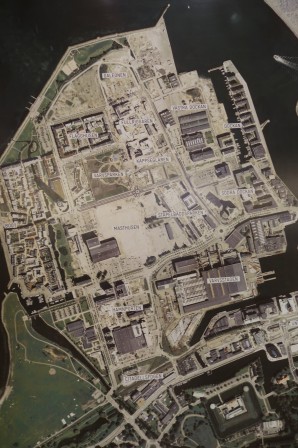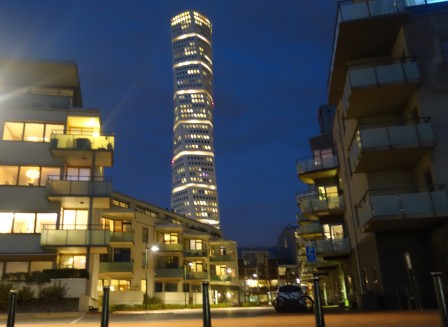L’écoquartier Bo01 ou la force d’une expérimentation ambitieuse
Située à l’extrême Sud de la Suède, juste en face de la danoise Copenhague à laquelle elle est reliée par un pont depuis 2000, Malmö (300 000 habitants, 3ème ville de la Suède) serait, selon notre guide, à la fois la ville du vent et la Marseille de la Scandinavie.

Visiter Bo01 sous la pluie et le vent n’était peut-être pas la meilleure manière de découvrir ce célèbre écoquartier (même si y retourner de nuit permet de découvrir les intérieurs grâce aux grandes baies vitrées sans rideaux). Mais, à défaut d’en apprécier l’ambiance, on a pu mesurer à quel point l’ambition initiale (un quartier totalement autonome sur le plan énergétique) continue à produire ses effets… 15 ans après (le nom fait référence au Salon de l’habitat qui s’est tenu à cet endroit en septembre 2001).

La zone de Bo01 correspond à la première phase de développement du Port Ouest (Västra Hamnen), devenu une friche industrielle après le déclin de l’activité navale et la fermeture de l’usine Saab. Elle représente une surface de 9 hectares, sur un total de 30 hectares pour l’ensemble du Port Ouest. Aujourd’hui, 4.000 personnes vivent dans ce quartier, et les projections, à l’échelle du site de Västra Hamnen, tablent sur 30.000 habitants à l’horizon 2030.
Citons le bilan qu’en tire Gary Austin, dans son étude de cas : « Case study and sustainability assessment of Bo01, Malmö, Sweden » :
« Bo01 was a high-risk enterprise inspired by a city in crisis. Mounting the largest European housing exposition was an intrepid step exposed to the scrutiny of the international community. In order to succeed, innovative planning methods that emphasized the collaboration of government, designers, and developers were created through “Creative Dialogues” to produce a consensus of what could be accomplished under a time constraint. The result was the Quality Program, a simple document outlining the minimum standards for architecture, landscape, energy, water, waste management, and biodiversity. Included in the Quality Program are the Green Space Factors and the Green Points list that reinforce the master plan and resulted in beautifully diverse and effective landscapes. The holistic definition of sustainability by the visionary planner resulted in aesthetics and social opportunities that matched the high levels of technical performance. The project supports human physical and psychological health through immediate access to open space, walkable neighborhoods, and opportunities for social interaction or solitude. There were missteps, of course. The cost of the units was too high to serve moderate and low-income residents. The desirability of living in Bo01 exacerbated this problem since demand caused unit prices to double between 2001 and 2007. However, the success of the development validated the planner’s contention that high quality architecture, landscape architecture, and attention to the social environment were important aspects of sustainability. The energy efficiency goals set in the Quality Program were not met due to the method used to calculate the energy budget of the proposed buildings and perhaps because the energy supply was not a limiting factor.
There are many significant accomplishments equal to the amazing 100% renewable energy system. With over half of the development area dedicated to open space, the population density is a positive example of a compact urban settlement that doesn’t diminish the residents’ quality of life for the sake of density. The landscape is diverse and beautifully illustrates responsiveness to the environmental context. The public spaces are compelling and attract local and foreign visitors to the seaside. The semipublic courtyards offer increased detail and privacy, create supportive microclimates, and implement biodiversity measures. The demonstration of a surface-only stormwater management system is an important achievement. The designers showed how planning and attention to detail can solve functional, aesthetic, and safety concerns and create a project feature valued by the residents.
The impact of Bo01 is significant. Thousands of professional planners, architects, landscape architects, and others interested in innovative housing and urban development visited the project during the exposition and since. The high profile of the project caused the positive and negative aspects of the project to be publicly disseminated internationally. Within Sweden, and especially within Malmö, the successes of Bo01 and the subsequent revisions to correct problems have been incorporated into other developments.
The goals of the next phase of the redevelopment of the Western Harbor (Flagghusen, a 16-building, 600 apartment unit project) were adjusted to increase the parking capacity slightly (0.75 parking spaces per unit), to increase the density significantly, to decrease the purchase and rental cost of the units, to improve both the energy use calculation methods and to rely on more cost effective methods to achieve more modest building energy efficiency goals (120 kWh per m2 instead of 105). The green space factor and green points concepts have been adopted by the city for system-wide application ».